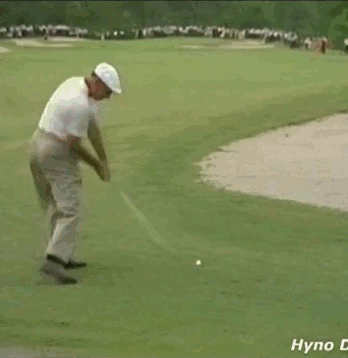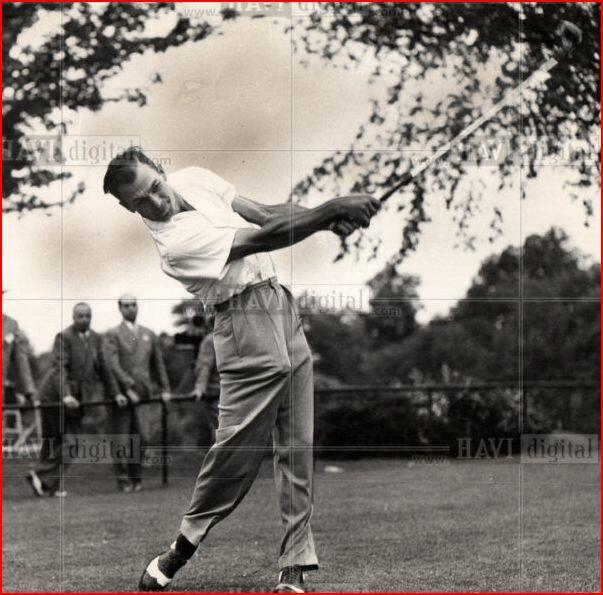
Just a day late for Veteran’s Day…but better late than never…hats off to those both past and present.
Always liked this image about the shoulders internally oriented at address, with a concave chest feel…like naval radar seeking out the enemy. ![]()

Just a day late for Veteran’s Day…but better late than never…hats off to those both past and present.
Always liked this image about the shoulders internally oriented at address, with a concave chest feel…like naval radar seeking out the enemy. ![]()
NRG, who are you quoting?
Pretty sure thats from the 2008 Ben Hogan calendar. Included within it is Hogan’s speech from June 1988.
This one I think
amazon.com/gp/aw/d/B000WJ0GL … 1_1&sr=8-1
He clearly discribes how he values acceleration through impact and left arm supination through impact and up to the finish.

The right arm is not driving straight as most think. The left knee is not locking up either. Two key elements there of
Hogan’s action.
Thanks for posting.
Another clear view of Hogans right arm through impact.

Camera angles can be very deceptive. For instance here, in the second frame we are looking more at the back of the right arm as it moves more in a circle and works left. You can see how hard the left shoulder moves away from the ball. It appears that the right arm is straightening more than it is… but this is because we are looking more at the back of the elbow than the side of the elbow in the first frame.
The great thing you can see here is how everything is moving together. Hips, torso, shoulders, hands are all working in nearly perfect unison. This concept is falling on deaf ears with the modern golf swing. Generally speaking, the body simply can’t turn fast enough to support the velocity requirements of today’s professional expectations. The body works better at slower speeds, but higher thrust. This is what the great ball strikers of the past did.
Here are some swings from 1953 and 1965. Here you can see the right elbow disconnect from the body right after impact. I’ve only seen this when he’s wielding a wood or a long iron. With shorter irons the disconnection is for the most part not discernible.

I would think, speed, acceleration and dynamics would make it impossible to keep the right elbow glued to the right hip, post impact. IMO
Steve
It’s interesting because I’ve only found footage of him doing this after his accident. In his Power Golf days his connection appears to be much tighter, although good quality video is more difficult to come by from that era.

If a camera were moving from A to B to C then you would have a more accurate depiction of the right arm.
There may very well be some “daylight” if the camera were on the “A” line.
It has to be understood that the torso is rotating around in a circular fashion, while the camera is not.
What you can compare is how Hogan might look compared to others players, and in this case Hogan I am sure is tighter with the right elbow and less straightening is going on than just about anyone I have ever seen.
I think its impressive how tightly packed he was able to keep the right arm to his body through impact and limit it straightening out especially considering he’s hitting a 3wood here. Its pretty easy to keep the right arm tight to the body and bent post impact with short irons or partial shots but i havent seen not many players do it this well with longer clubs.
If you know what to look for…
it is a rare thing of beauty for sure.
Here’s what I think is 1948 Los Angeles open showing again that that sucker is bent. Seems to be independent wrist roll even with bend arm?

because he needs to get to this at some point

Flexible wrists and strong hands make for a good combination.
Don’t know if this is a ying-yang symbol, simply a coupler, or a method of controlling forces and slack, but whatever it is, it is solid with flexibility while keeping vertical travel to a minimum. Check out how trains handle slack during both forward and backward travel from the station…interesting stuff if you believe Hogan hit the ball with the caboose. ![]()

And would you say that flexing the right knee and maintaining spine tilt late into P4 provides the leverage to pull that club out and around?
Paul C,
Good to see you pop up again. Great GIF isn’t it. I have been watching it over and over…letting is sink in…the aggressiveness is amazing…and he was mid50s here. The sword gets a lot harder to pull with this short an arm travel and this fast a BS.